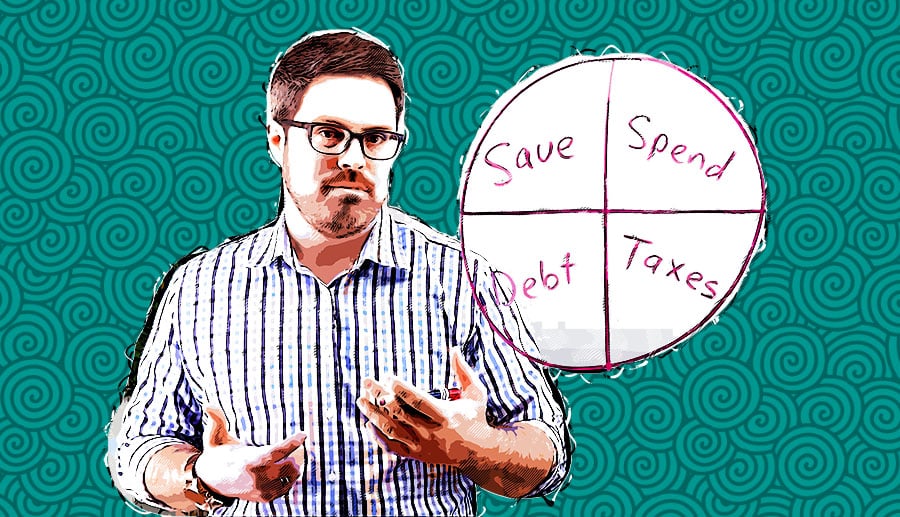The recent political buzz has caused me to reflect more on spending, economics, and my own fiscal habits over the years.
I remember the moment, 15 years ago, when I decided to start up my own financial planning firm. After reviewing my family’s budget, I determined that we’d remain financially stable as long as I could earn $5,000 each month. This was no small task since at the time I made around $3,500 per month as an associate advisor.
It’s interesting for me to examine my fiscal frame of reference at that time. What I considered to be a plush income then, would not even come close to supporting my family today. Most people can relate to this––our lifestyle expectations grow as our careers progress. The income we think we need seems to always be just slightly more than we make today.
That takes us back to my story. When I was just getting my business off the ground, my wife and I were expecting our first child, and things were getting real, really fast. I put in many late nights and early mornings during those early years. It was a success, both in terms of new clients, and in terms of income. Instead of earning $5k per month, I ended up earning almost double that amount.
I don’t share this account of my modest success to toot my own horn. Many of you have had far more success than I in your first year. The irony was that even though I made more money than expected, it didn’t go as far as we had projected. There were unexpected medical bills for our first child, a necessary radon pump for our basement, some grass and a fence for our yard, and eventually the basement needed to be finished to make room for our second child. The additional money I earned was matched with additional expenses.
A question which I had heard from clients over the years kept coming to my mind, “Where did all the money go?” I made more money, but I didn’t have as much to show for it as I thought I would.
I realized that I needed to develop a system to help me stay accountable to a precise budget. Then I could teach clients how to do the same. After a few years of trial and error, I developed my income philosophy.
The income you take home can only go to one of four places:
Taxes: Uncle Sam takes a massive chunk, anywhere from 0% – 40%+ depending on the state where you live and how much you make. And the government takes its share forcibly—you don’t have much choice but to pay it.
Spending: You gotta live. Food, cars, vacations, pet spas, and more. Your range of personal spending is highly dependent on your habits. You might be spending as little as 10% or as much as 80%+ of your annual income.
Debt: Some people have significant student, business, and real estate debt. If you’re not careful, the percentage you pay toward debt can make it hard for you to grow your net worth. The rate at which you pay down your loans is integral to your overall financial plan. Too high, and you’ll be illiquid and asset poor. To slow, and you’ll end up buried, with no way to leverage yourself into a better situation.
Savings: A healthy savings rate can range from 10% – 30% depending on your income level. If your income is below average, you might only be able to squeak out 10%––and you shouldn’t feel bad about that. Very high earners may need to have a savings rate of 30% or more to maintain their desired lifestyle in retirement. The goal is to simply do the best with what you have.
It’s not a complicated budgeting process, but I think there’s something about the simplicity that really works for most people.
I recommend you quickly get to the point where you can measure how your client’s income is being distributed among these four categories. You and your client should be able to fill in the blanks and say: my taxes are __%, my debt is __%, my personal spending is __%, and my savings rate is __%.
Once you have these indicators (Debt Rate, Tax Rate, Spending, and Savings), then you can start to provide solid advice.
For example, you could say:
“Your savings rate is simply too low (7.4%) for your income level ($126k).”
Once you get more data on your ideal customer and start to develop some benchmarks, your language can become even more targeted and helpful:
“Your peer group average savings rate is 17.2% and your savings rate is only 7.4%. That concerns me a little bit. We need to take a closer look at your debt, taxes, and spending so we can increase your savings rate.”
One of the most important things you can do as a financial advisor is to encourage your clients to think about their income holistically. The amount of their income that is dedicated to each area will impact both their financial and psychological well-being.
By incorporating key financial health indicators into your advice process, you can offer more precise and helpful advice to your clients. That advice empowers them to live more fully in the present moment. They’ll know they’re in the capable hands of a comprehensive advisor who has a holistic strategy. The method enables clients to make tangible adjustments to their behaviors that increase their net worth and set them up for a comfortable future.

